Do some research into artists and illustrators who have used ceramics as a surface for their image making. You might also want to look at ceramicists who have a strong link with image-making in their own work. Find contemporary examples as well as exploring older ceramics traditions. What sort of motifs feature regularly? Could you say there is a visual language of ceramics?
For this Research Point I ended up reading quite in depth about various historic periods and the associated pottery of the time (before even contemplating trying to find present day examples). I realised that I was perhaps going into far too much detail for the requirements (a tendency I seem to have, as previously mentioned by my tutor), so, considering I had already spent quite a long time on this part of the unit, I decided to try and be more succinct in summarising what I learnt in terms of the images used to decorate the pottery, when discussing the older traditions, rather than how it was made and details of no real relevance.
Examples of Older Ceramics Traditions
A couple of general key points that I noted about the ceramics from the ancient times included that the pottery was functional and used in everyday life as containers/vessels for a wide variety of content, such as olive oil and wine. Once a particular shape/form had been perfected, this would be replicated as a staple.
For this section of the research I selected Minoan and Greek pottery.
Minoan Pottery
The decoration of the pottery created by the Minoans of Crete (2600-1500 BC) was highly influenced by the natural world, depicting plants and animals. In particular, being an island-based society, the sea was a common theme. I really liked the black, bold designs, such as that shown on the Octopus vase below. The creature’s curling tentacles are perfectly suited to the curve of the vase and the eyes, almost cartoon-like in style, give it a real sense of character.
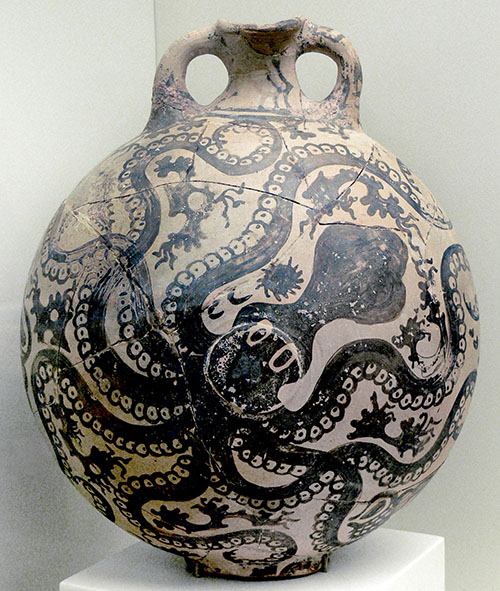
Minoan pottery was also often decorated with geometric shapes and bold patterns, as can be seen in the example below.
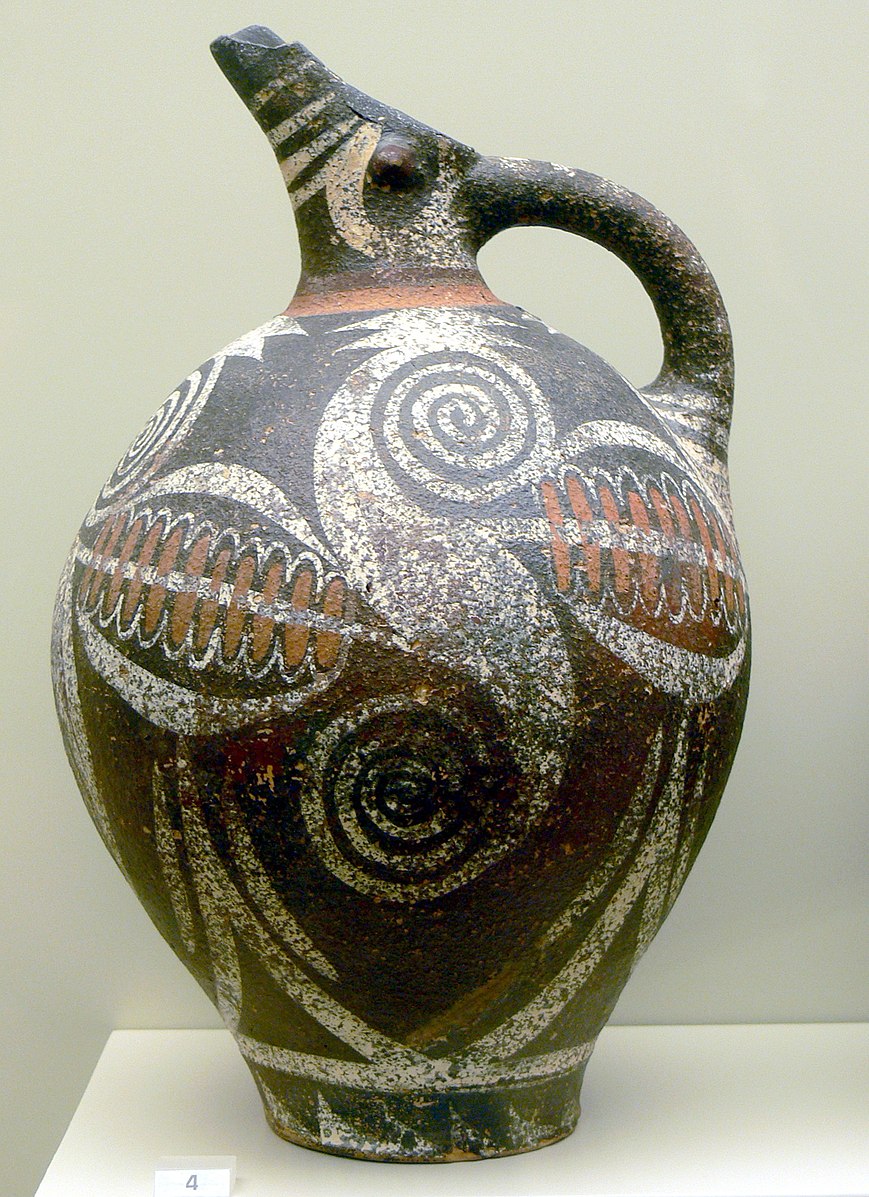
Source: Wikimedia Commons.
Greek Pottery
Throughout the time of the Ancient Greeks (c.1000 to c.400 BC), the pottery was decorated in four main styles: Geometric, Corinthian, Athenian Black Figure and Athenian Red Figure.
Geometric: designs consisting of precisely drawn circles, semi circles and horizontal lines, as well as upright triangle points (zig-zags). This gradually moved towards including stylised, simple, human figures, animals and birds.
Corinthian: designs influenced by burgeoning trade with Eastern civilisations and included exotic animals.
Athenian Black Figure: designs became more sophisticated and depicted mythology and battle scenes, as well as religious, social and sporting events. As the name suggests, the figures in the designs were black on the red clay surface, although the faces of women were coloured white.
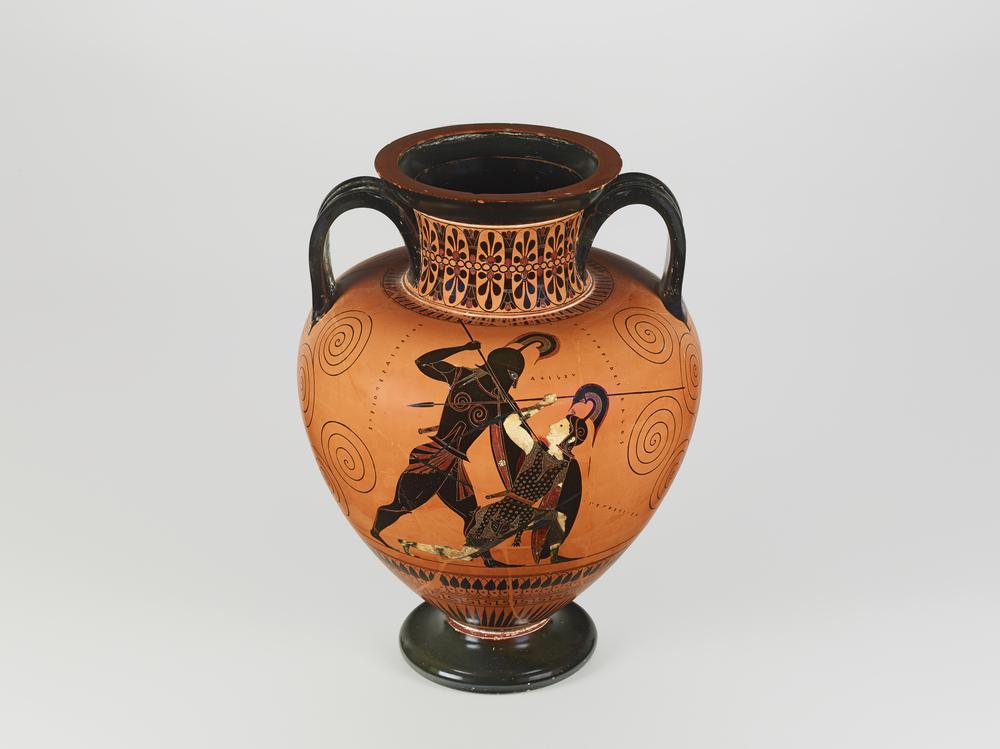
Athenian Red Figure: as the name suggests, these designs, in terms of colour, were the exact opposite of the above, with the figures being coloured but the red clay and outlined/surrounded by black. The figures in this style also became more realistic in appearance, showing everyday life in Ancient Greece.
Two other points I noted about Ancient Greek pottery were that the purpose of the ceramic container/vessel was often shown in the decoration and that figures were generally shown in profile and there was very little, if any, perspective used (in the sense of modern, Westernised perspective drawing).
Examples of Contemporary Ceramics
Grayson Perry
Although I knew who Grayson Perry was, I did not know much about him (apart from the obvious, media portrayal of him) until I came across Grayson’s Art Club, all three series of which I watched on demand this year. I really grew to like his down to earth approach and he comes across as a genuinely decent person. I also appreciated Perry’s confidence to be himself and not follow the norms of societal expectations. I went on to watch all the available programmes Perry has created so far, as well as read several of his books.
The pieces he produced on Art Club were slightly more restrained than some of his usual works, which tend to be quite explicit and thought-provoking. I particularly like how Perry bases quite a bit of his art on his childhood teddy – Alan Measles (what a great name). I later discovered that, following a difficult childhood and the resulting psychotherapy sessions, Perry learnt that he considers Alan Measles to be a representation of the father figure he never had.
An important point to make about Perry’s work is how he uses traditional methods, such as ceramics, to produce what, from a distance appear to be well-made, attractive vases and so on. It is not until the viewer really gets in close and actually looks at the illustrations that adorn the items that it becomes clear the subject matter is often hard-hitting, often based on subjects such as sexuality/gender, deprivation/inequality, childhood, abuse, politics and the like.
It was quite difficult to take an in-depth look at Perry’s work online, due to the nature of these being three dimensional and viewed on a flat screen. I also found I could not understand what the underlying message was for many of the pieces, but recurring images included representations of Perry in all his guises, Alan Measles and Perry’s family, alongside those of famous people, such as politicians and ‘ordinary’ people in everyday situations.
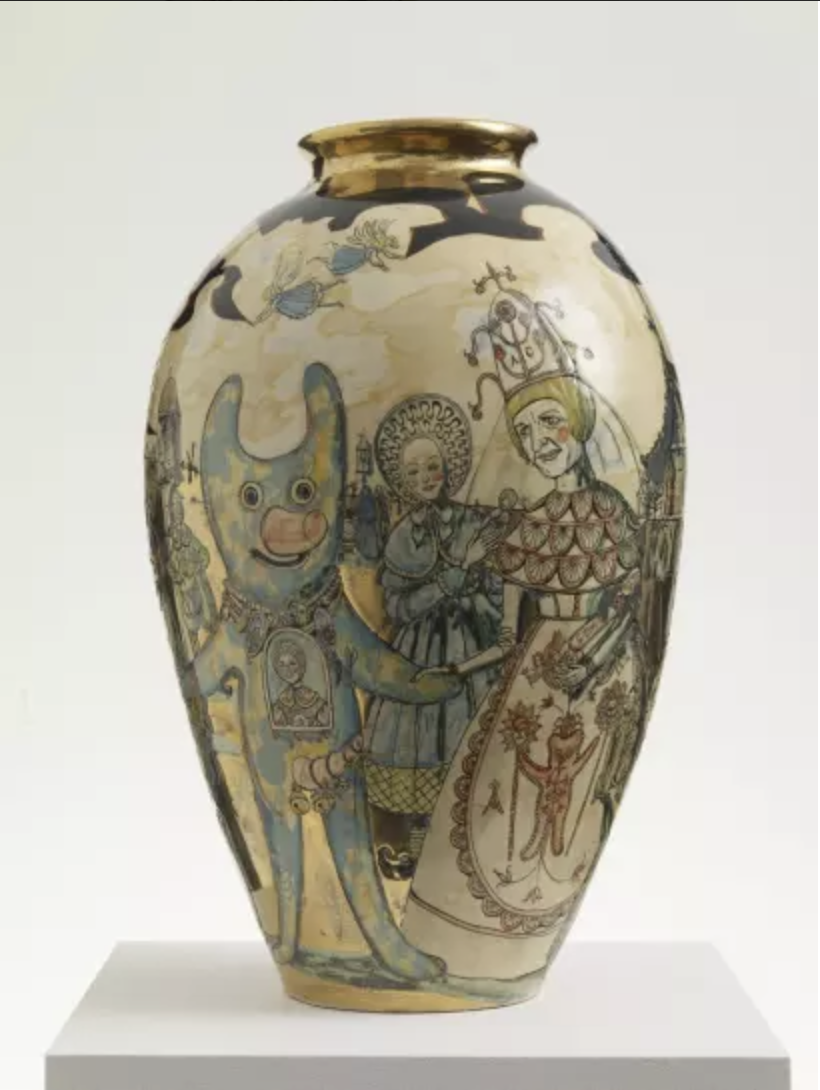
Becky Lloyd
Through the research I undertook I became aware of sgraffito, which can be roughly translated from Italian as ‘to scratch’. This is a method used for decorating ceramics that really interested me and I quickly realised it is almost identical to scratchboard, which I previously attempted in an earlier exercise. The technique of sgraffito involves covering unfired pottery in coloured slips or glazes and using a sharp instrument to scratch away the top layer to reveal the underneath.
Sgraffito was first used by artists around the 16th century and is still a popular choice in the present day (Grayson Perry regularly uses this method).
An example of a contemporary artist using this technique is Becky Lloyd. Her hand-thrown pottery is covered in black slip and Lloyd then uses a sharp knife to scratch away this top layer to reveal the white underneath.
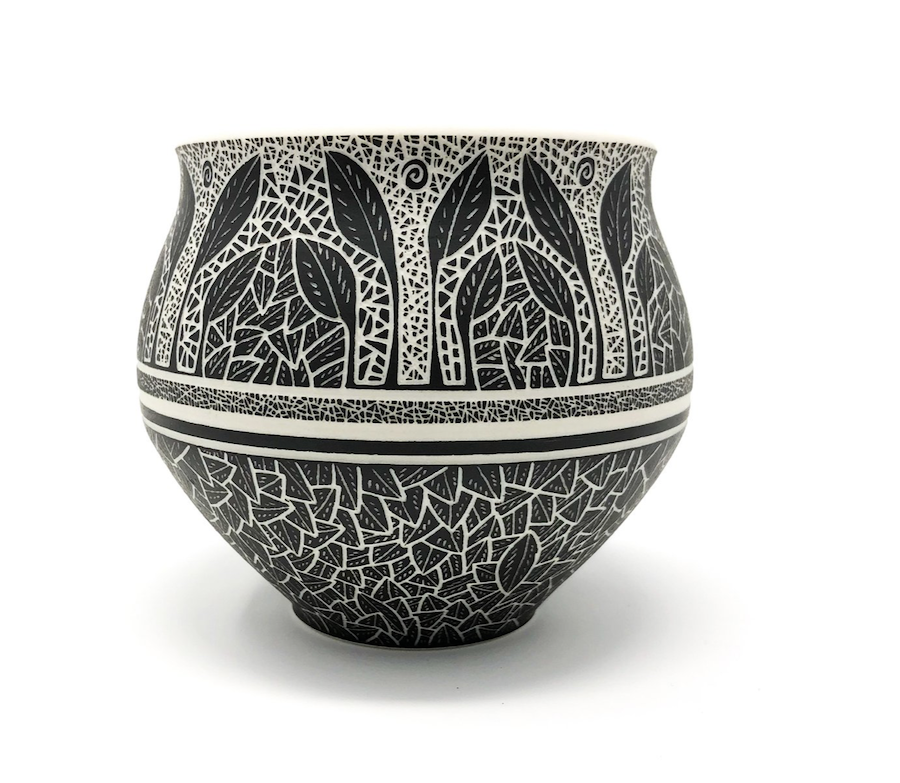
I really liked the bold designs using just black and white. Lloyd seems to mostly focus on using leaves for the illustrations, along with various simple shapes, horizontal lines and extremely detailed patterns of interlocking shapes. The style of Lloyd’s designs reminded me of some of the ancient, traditional ceramics that I had viewed earlier, which also tended to favour the use of strong, black-focused designs.
Mariko Paterson
It seemed to be quite a challenge to find ceramicists that focus on illustrative work (or vice versa), but I did manage to discover another interesting example in the form of Mariko Paterson. I was slightly reminded of Grayson Perry’s work in terms of style and content, but less explicit. Like Perry, some of Paterson’s work is political or ‘confrontational’ in nature, but she also has some just plain quirky pieces on offer.
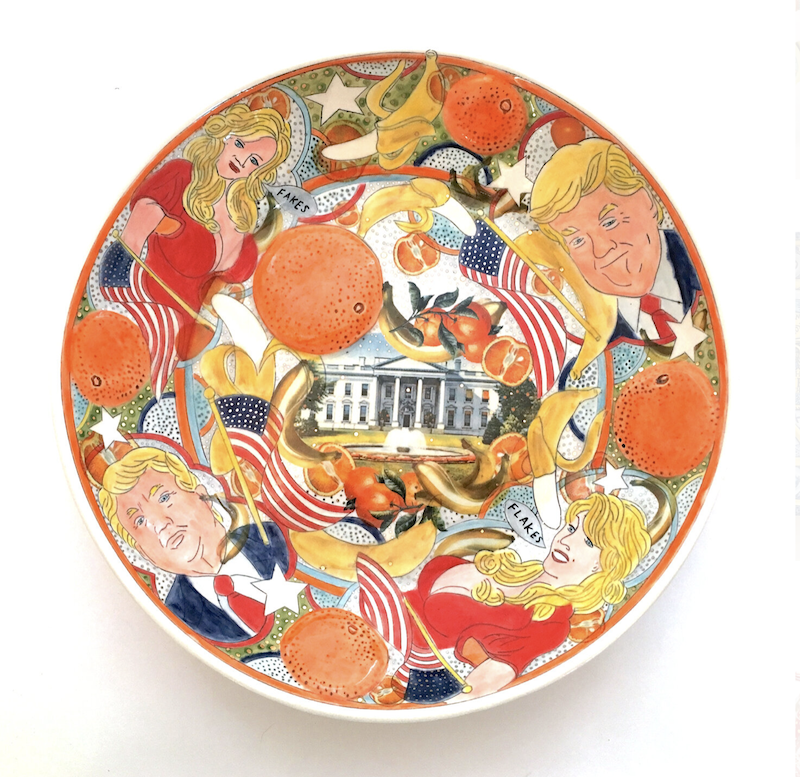
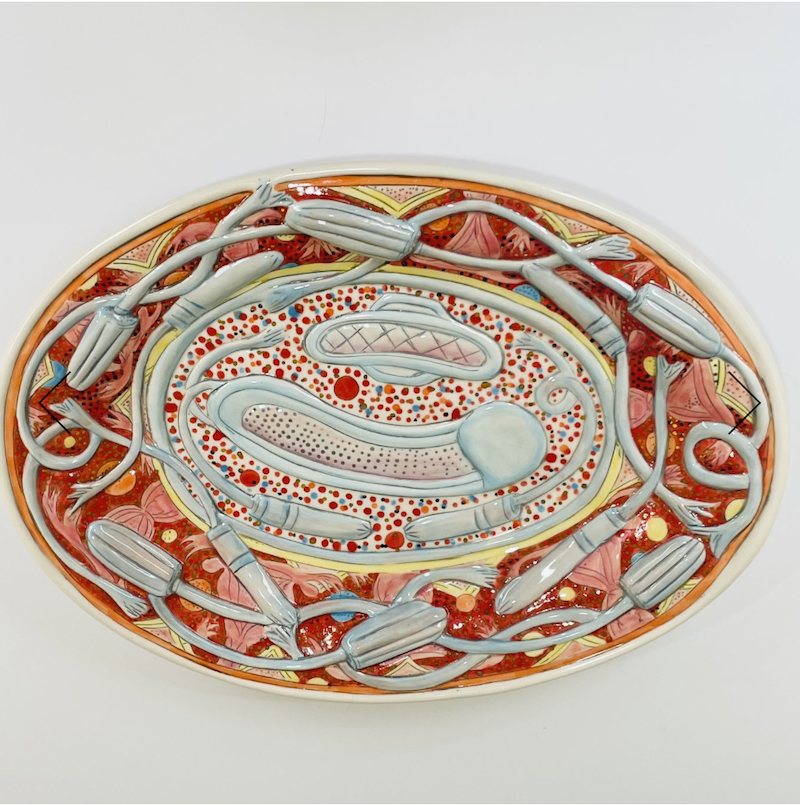
Final Thoughts
Prior to this Research Point I had not considered ceramics as a medium for illustration, so I learnt a great deal. As previously mentioned it was quite difficult finding examples, mostly due to my lack of prior knowledge and thus being unsure of where to look, but I hope this is an area of illustration I can find out more about. I was especially interested in Minoan designs and the sgraffito technique.
The common themes and motifs that I found were often present, particularly in the traditional examples, included:
- Religious, social, political and cultural practices.
- Gods
- Patterns and symbols – simple shapes and lines, such as spirals and zig-zags.
- Animals – relative to location.
- Plants – particularly leaves.
- Humans (stylised) – often going about their everyday lives or depicting what the ceramic vessel/container is to be used for.
- Commentary on everyday life – contemporary examples tend to be more critical.
It became very apparent to me that ceramics can be used as medium for illustration, just like paper, canvas, digital screens, etc, and thus provides a method to visually communicate a message to an audience, as seen in the examples discussed above, rather than just being considered decorative. It is a particular skill to be able to apply an illustration that would usually be on a flat surface and transfer this onto a three dimensional object.
Bibliography
British Museum (n.d.) amphora. Available at: https://www.britishmuseum.org/collection/object/G_1836-0224-127 (Accessed 26 November 2023).
Cartwright, M. (2018) Ancient Greek Pottery. Available at: https://www.worldhistory.org/Greek_Pottery/ (Accessed 26 November 2023).
Cartwright, M. (2012) Black Figure Pottery. Available at: https://www.worldhistory.org/Black_Figure_Pottery/ (Accessed 26 November 2023).
Cartwright, M. (2012) Minoan Pottery. Available at: https://www.worldhistory.org/article/391/minoan-pottery/ (Accessed 26 November 2023).
Cohen, L. (2015) Ai Weiwei: a beginner’s guide. Available at: https://www.royalacademy.org.uk/article/ai-weiwei-beginners-guide (Accessed 27 November 2023).
Gay, P. (n.d.) Pino Gay. Available at: https://www.pinogay.com/2020 (Accessed 27 November 2023).
Ignacio See, G. (2019) These 13 Ceramic Artists are Reshaping the Medium. Available at: https://theartling.com/en/artzine/contemporary-ceramic-artists/ (Accessed 27 November 2023).
Lloyd, B. (2023) Lloyd Pottery. Available at: https://www.lloydpottery.com (Accessed 27 November 2023).
Mulder-Slater, A. (n.d.) All about Minoan Pottery. Available at: https://kinderart.com/blog/minoan-pottery/ (Accessed 26 November 2023).
Paterson, M. (n.d.) Forage Studios. Available at: https://foragestudios.com (Accessed 28 November 2023).
Pera Museum (2022) Contemporary Ceramics From Around the World: 10 Artists, 10 Works. Available at: https://www.peramuseum.org/blog/contemporary-ceramics-from-around-the-world-10-artists-10-works/1577 (Accessed 27 November 2023).
Royal Academy of Arts (n.d.) Sir Grayson Perry. Available at: https://www.royalacademy.org.uk/art-artists/name/grayson-perry-ra (Accessed 27 November 2023).
Tsang, J. (n.d.) Artworks by Johnson Tsang. Available at: https://johnsontsang.wordpress.com/page/1/ (Accessed 27 November 2023).
Victoria Miro (n.d.) Grayson Perry. Available at: https://www.victoria-miro.com/artists/12-grayson-perry/ (Accessed 27 November 2023).
Wikimedia Commons (n.d.) File:AMI_-_Oktopusvase.jpg. Available at: https://commons.wikimedia.org/wiki/File:AMI_-_Oktopusvase.jpg (Accessed 26 November 2023).
Wikipedia (n.d.) Kamares ware. Available at: https://en.wikipedia.org/wiki/Kamares_ware (Accessed 26 November 2023).
Wikipedia (n.d.) Mycenaean pottery. Available at: https://en.wikipedia.org/wiki/Mycenaean_pottery (Accessed 26 November 2023).
Wikipedia (n.d.) Sgraffito. Available at: https://en.wikipedia.org/wiki/Sgraffito (Accessed 26 November 2023).